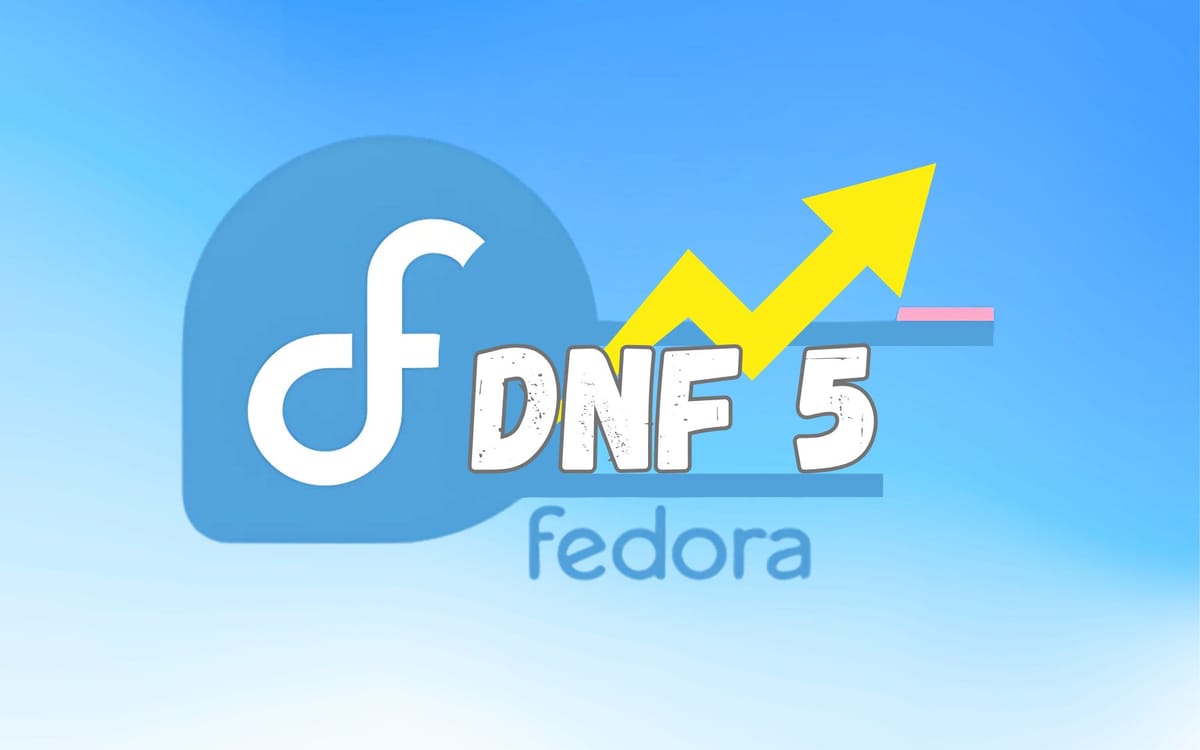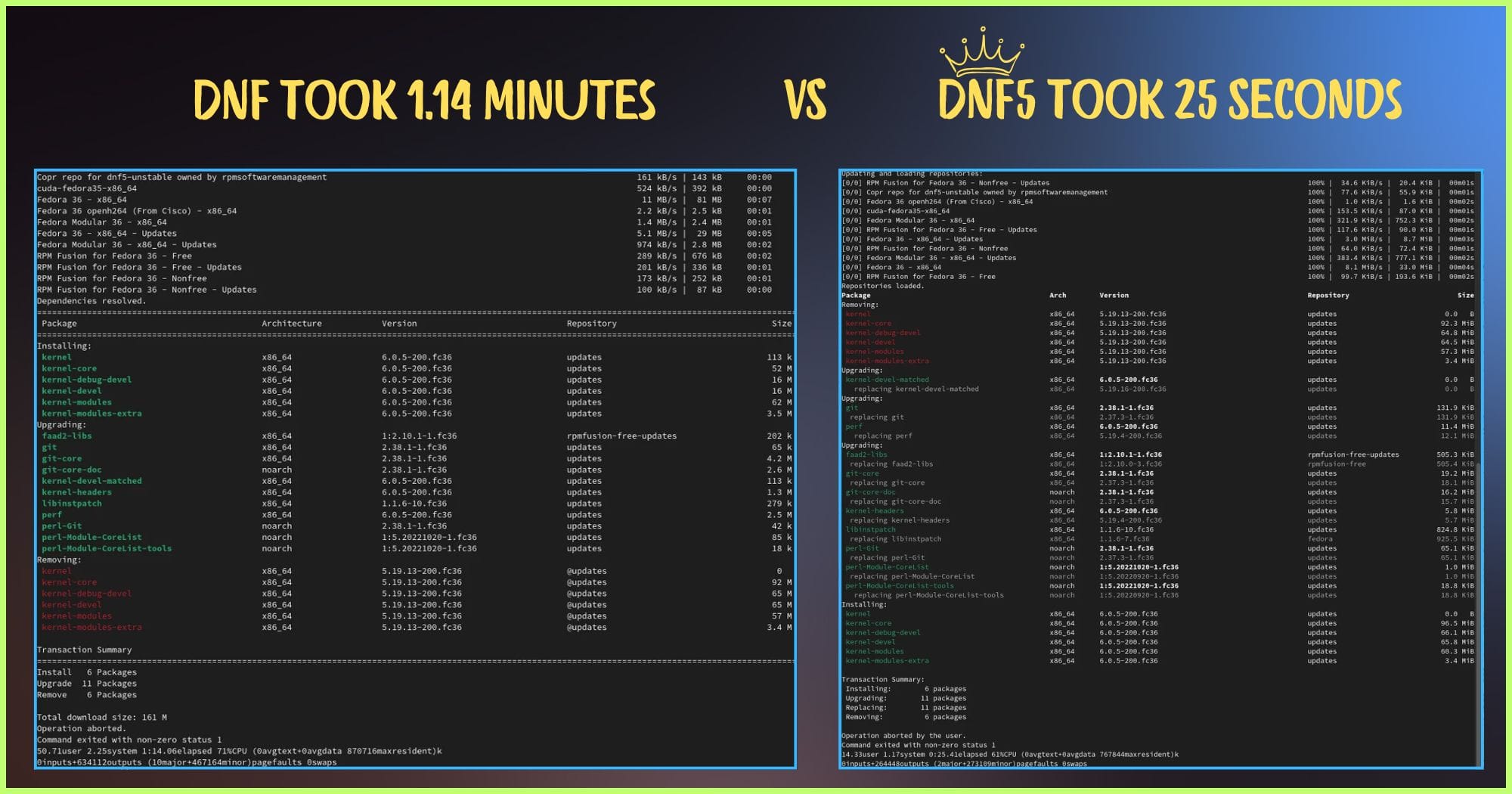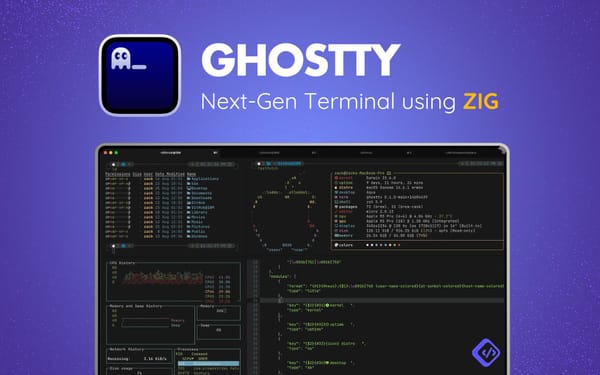DNF vs. DNF5: A Detailed Analysis of Performance Improvements
DNF5, Fedora's next-gen package manager, brings faster performance, lower memory usage, and improved architecture. Rewritten in C++, it replaces DNF in Fedora 41, offering streamlined package management and reduced system downtime. Learn about its key features and performance gains.

The Fedora Linux is always renowned for its commitment to integrating the latest and cutting-edge software and technologies. This have been proved once again by the recent release of DNF5 which is the successor to DNF (Dandified YUM), the package manager for Red Hat-based Linux distributions and derivatives.
Despite both tools fulfilling the same essential function of managing software packages within RPM-based distributions, DNF5 stands out by offering substantial advancements in performance, functionality, and ease of use.
In this article we will explore new advancements brought by DNF5 and compare their key features, highlighting significant speed enhancements in DNF5, that is sparking both excitement and curiosity within the community.
The Evolution from DNF to DNF5
DNF (Dandified YUM) has been Fedora’s default package manager for a long time, praised for its reliably and extensive feature set. The evolving landscape of package management necessitates the continuous refinement of its underlying tools. DNF5 emerges as a meticulously reengineered successor, strategically designed to overcome performance limitations and elevate the overall user experience.
At the heart of DNF5’s improvements lies its new foundation: the libdnf5 library. This replacement for the older libdnf library is optimized for efficiency, allowing DNF5 to deliver faster performance without compromising on functionality.
Performance Test: DNF vs. DNF5
We conducted a straightforward speed test to compare DNF and DNF5 under identical conditions. The commands used were:
- DNF:
sudo time dnf upgrade --refresh --downloadonly - DNF5:
sudo time dnf5 upgrade --refresh --downloadonly
These commands simulate a typical package upgrade process while refreshing metadata and downloading updates without applying them.

Results:
- DNF: Approximately 1 minute and 14 seconds
- DNF5: Approximately25 seconds
The results demonstrated a dramatic reduction in execution time, with DNF5 completing the task in one-third of the time taken by DNF. This improvement highlights the architectural and performance optimizations introduced in DNF5.
Fedora users and developers shared valuable insights on various forum discussion, providing context to the performance gains.
DNF5 Detailed Analysis
As of now Fedora has successfully transitioned to DNF5 as the default package manager, marking a significant milestone in the evolution of its software management system. This transition, completed with the release of Fedora 41, introduces notable performance enhancements and a more streamlined user experience for Fedora users.
- Architectural Overhaul
DNF5's development involved a comprehensive rewrite, shifting from Python to C++ and utilizing the new libdnf5 library. This architectural transformation has resulted in improved performance, reduced memory usage, and faster dependency resolution, addressing the limitations of its predecessor, DNF.
- Integration into Fedora
The integration of DNF5 into Fedora was a carefully planned process. Initially slated for Fedora 39, the transition was postponed to ensure stability and feature parity. After thorough testing and development, DNF5 became the default package manager in Fedora 41, released in October 2024.
- Community Feedback and Future Outlook
The Fedora community has played a crucial role in the development and integration of DNF5, providing valuable feedback throughout the process. While the transition has been largely successful, ongoing monitoring and user feedback continue to drive refinements and improvements. The adoption of DNF5 underscores Fedora's commitment to innovation and enhancing user experience in package management.
Key Differences Summarized:
| Feature | DNF | DNF5 |
|---|---|---|
| Programming Language | Python | C++ |
| Performance | Faster than YUM, but can have performance issues | Significantly faster, lower memory usage |
| Architecture | Multiple libraries and tools | Unified architecture |
| Development | Existing codebase | Complete rewrite |
In summary, the shift to DNF5 represents a significant advancement in Fedora's package management capabilities, offering users a more efficient and responsive tool for software installation and maintenance.
Why This Matters ?
The speed enhancements in DNF5 are not just a technical milestone but also a testament to Fedora’s forward-thinking approach. Faster package management translates to improved user productivity, especially in environments where frequent updates and large repositories are the norm.
Moreover, the reduced time for operations like metadata refreshes and package downloads minimizes system downtime, an essential factor for both desktop and server users.
Conclusion
The DNF5 speed test results underscore its potential to redefine package management in Fedora. While it is not yet the default, its promising performance and architecture improvements make it a strong candidate for adoption in future Fedora releases.
For Fedora users, testing DNF5 now offers a glimpse into the future of package management. As with any major software change, feedback from the community will play a critical role in refining and perfecting this new tool.
Let us know your thoughts: Have you tested DNF5? What are your impressions? Let’s discuss in the comments!





